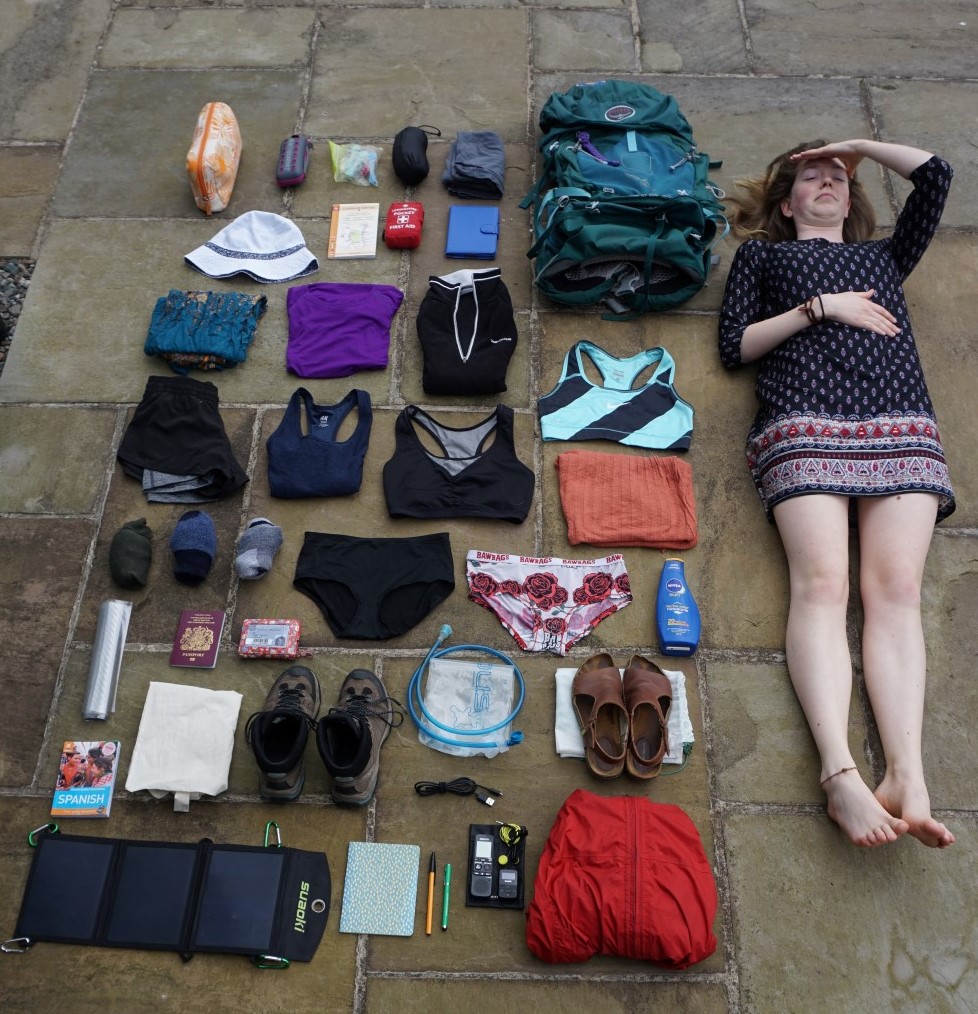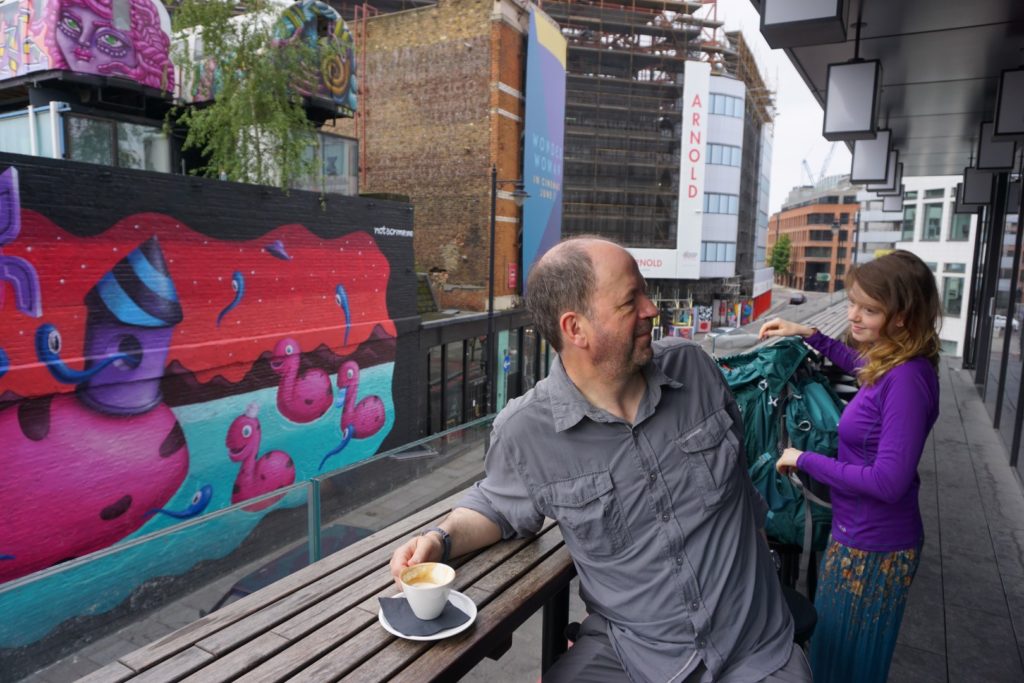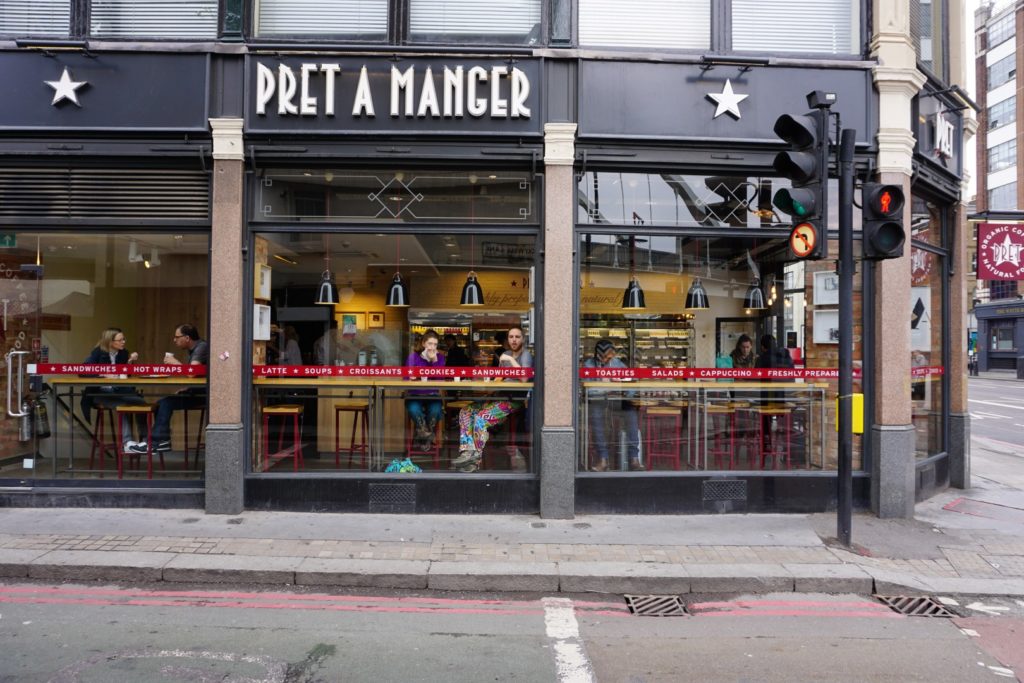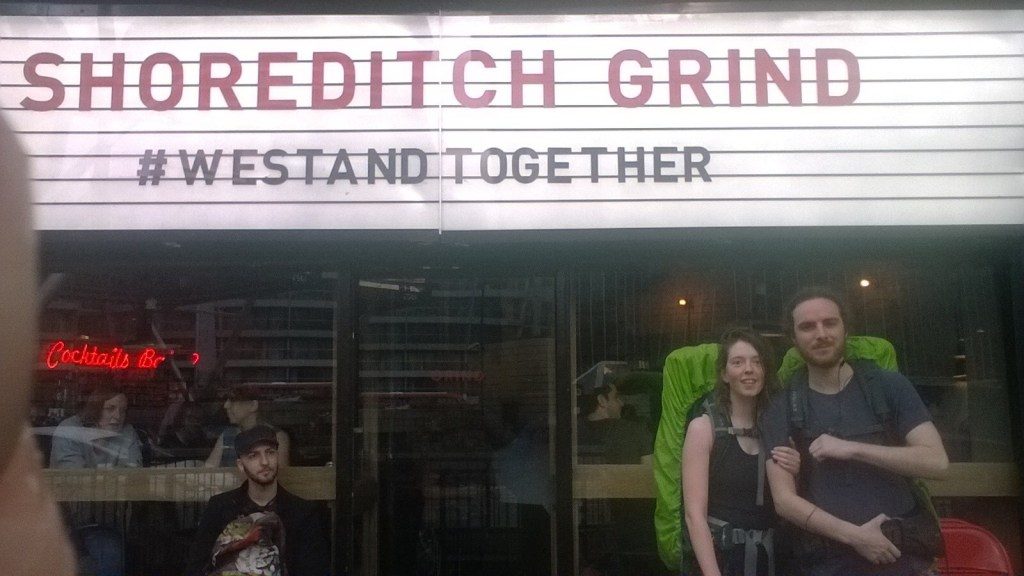Jen: Hi friend! Welcome to the extremely long and in-depth part of the blog where I tell you what I will be carrying in my pack over the next month.
I fortunately have a good idea of what I wanted to bring with me and the kind of weight I could carry based on my walking of the Camino Frances last year. I made the usual pilgrim mistake of carrying far too much, and sent home 2kg of sleeping bag and mat about two weeks in to my trip. I’m keen not to make that mistake this time so I packed roughly 7.4kgs but may (hopefully) reduce that along the way. Here is my breakdown (starting from the top left of the picture down the bottom*):
1. Toiletries bag: inside I’m carrying a toothbrush (bamboo – lighter and zero waste), toothpaste, deodorant, a bar of Lush soap and a Lush shampoo/conditioner bar (not carrying bottles saves a lot of weight and Lush products helpfully come in a small tin), a razor handle and two heads, Nivea moisturiser (a small luxury I originally travelled without, but after a long day of walking in the sun and more regular shaving my skin could really do with some tlc), sanitary pads (a few), a mooncup (would 100% recommend, but do get used to it before you go!), factor 30 face cream, travel wash, and factor 30 lip balm (lips get burned too I discovered). This is quite a long list but there’s nothing here I won’t use on a daily basis, and when the travel wash and shampoo bar runs out I’ll just use soap.
2. A fold up tiny towel. The first night after walking last summer (from St Jean Pied de Port to Roncevalles), my bunk was opposite an elderly 80 year old man who carried a tiny backpack filled only with a water bottle, a wallet, one tshirt and an enormous fluffy towel. To each their own on the towel front, but I quite like my tiny pink square. It dries quickly and is very light. Available from Amazon from as little as £7 (or check out camping store sales).
3. A bag of pegs (6 to be exact). Useful for hanging up clothes at the albergue and for pegging socks to dry on your bag as you walk.
4. A sleeping bag liner. Unlike the other two, I’m trusting the weather to be warm for me so that I won’t need a sleeping bag. I took one last time and swapped it for this tiny liner. Its literally a thin sheet for the purposes of covering you at night so and it folds up small and weighs almost nothing. They’re easy to buy in Spain (but are more expensive) – but make sure to bring earplugs because a snorter will bring out a level of irritation in you that you didn’t know you possessed (mine are foam and are in the liner pouch).
5. Sleeping shirt. Courtesy of my brother from whom I nicked this. I wear it at night – with trousers if I get cold but without usually. I’ll just pop a towel around me or tread quietly when heading to the bathroom at night. (Wash once or twice over the course of the trip).
6. Osprey Aura AG 65ltr. This is the part where I gush about this bag. Everything about it is wonderful – from the net back that stops you sweating through to your clothes, to the many pockets and solid hip hugging waist straps. The waist straps are the reason I went for this model and size, as smaller similar models don’t have such a solid hip structure. Firm straps around your hips are crucial as this is where the weight of the backpack is carried. I learned the hard way last time that carrying weight on your shoulders will cripple you for a number of days! My pack is called Nausicaä (from the Ghibli film), and we have developed a proper friendship over the last year. She’s a little large for the likes of the Camino (65lts would happily accommodate a tent and a sleeping mat too), but the back, shoulder and hip straps are well worth carrying a half empty bag for. There are two front pockets (in which I carry my purse and phone), two side slide-in pockets (ideal for suncream on one side and a map on the other), two pockets on the back of the bag (visible in the picture – the purple tie is tied to one zip) which are great for books and a solar panel charger I carry, one mesh net pocket (again visible in the picture), a bottom compartment that I use for carrying sandals, my raincoat and my sleeping bag liner, a rain cover pocket on the top of the bag (which you can stuff other things you’ll never need in – like the stone you carry from home to La Cruz de Ferro: the highest part of the Camino trail), another top pocket for documents, an inside compartment for a camelback, and finally great compression straps the whole way up the outside and inside of the pack. The back and shoulder straps are all adjustable and you can choose whether you’d like a long backpack or a short one. I chose the longer back (listed on the website as a WM) somewhat accidentally, but with so much room for adjustments, it fits me (5.6ft) just fine. Weighing 2.08kg overall, she is a little heavy – but through economising on other things, you can bring the weight down while still allowing for a bag with great back and shoulder support. She’s an expensive purchase for sure, but has definitely been worth it. Osprey also has a lifetime guarantee on this bag (and I believe all of their bags?) so if I ever do manage to tear a hole in one, they will replace it. Here’s a link to the official Osprey site but Tiso often has deals on Osprey bags that I took advantage of when buying Nausicaä (https://www.ospreyeurope.com/shop/gb_en/aura-ag-65).
7. A bucket hat. You’ll want a hat without a wide rim so that it doesn’t catch on your pack and fall off all the time: especially if you’re short like me and your pack is tall.
8. The John Brierley Map. This is a must and is the best map I found for the job. Available in a number of languages and for many of the official Camino trails to Santiago, it is updated each year with the correct prices of albergues, new trails and accurate phone numbers for accommodation. If you speak German, the ‘Outdoor’ Camino guide is also useful and can recommend local sites for each stop that might be of interest to the pilgrim.
9. First aid kit. Here’s an area that dad and I disagree on… I had little success with ‘Compeed’ blister plasters last time around (though admittedly other people swear by them), and found instead that a first aid kit consisting of regular plasters, paracetamol, a small bandage, medical scissors and a needle and thread quite sufficient. The main issue you’ll face will be blisters and the best way to cure them is not to get them in the first place. Make sure to break in your shoes before walking, fix any issues in your socks as soon as they come up, and dust you feet and socks with talcum powder before starting for the day – these things worked for me! Having good quality socks is also vital. If you are unlucky enough to get a blister in the first place, the best way to stop it reforming is to thread a clean needle, push the needle through the blister and out the other side, and then leave the thread in your foot to allow the blister to drain. If that’s too horrible for you, using sterilised scissors cut the blister open wide so that the old skin can fall off naturally but also can’t reform. It’s vile but it works! Plus it makes for some great photos for family and friends back home.
10. A Kindle. Don’t make the mistake of carrying three books around with you like I did last time. You’ll leave them at an albergue after the first few days to rid yourself of weight.
11. Comfy loose trousers. Etsy does a fine selection of lightweight trousers like these. One size fits all and they’re super light and breezy. They also dry quickly which is important (and why I sent my regular hiking trousers with zips to make them into shorts back home last time around). (Wash mostly after wearing).
12. A Rab lightweight technical top (purple). This one is long sleeved so I don’t have to wear suncream on my arms and works for those colder mornings. Technical wicking wear is again important for its quick drying time. This is important when you wash your clothes each evening. (Wash after wear).
13. A Craghoppers warm fleece (black). Early mornings can be a little nippy so a fleece is useful to have in an accessible pocket. (Wash once or twice).
14. A sports bra (striped). A normal bra would be fine (walking isn’t exactly intensive for that area), but sports bras tend to wash better and with less fuss, as well as dry quicker. (Wash after wear).
15. Shorts. These ones are from H&M and have a lining on the inside. Finding women’s shorts that are long enough is a challenge if you have long legs, so lined ones solve the issue of flashing at your fellow holy pilgrims. (Wash after wear).
16. A vest top (navy). Again from H&M, this one has wicking technology too but is half the price of a Rab shirt. (Wash after wear).
17. Another sports bra (black and grey). I took two sets of walking wear – one to wear and one to dry. (Wash after wear).
18. An orange loose dress. You’ll need something to wear while chilling in the evenings with other pilgrims and this dress is my favourite as it washes and dries quickly, and is very loose so I don’t sweat. You won’t walk in this item so it just needs to be something you’re comfortable to wear in a church, around the albergue in the evening, and in bed if you’re washing your other sleep shirt. (Wash once a week if that).
19. 3 pairs of socks. Mine are all Bridgedale, and of all the items you bring, your socks, shoes and pack are the most important. Finding socks that suit you can literally make the difference to whether you’ll get blisters or not. I favour a thicker sock, but with that does come heat rash. I had moderately bad heat rash on my ankles from the thick socks last time, and they were quite stiff from constant wear with only hand washes in between. I had forgotten how soft socks were meant to be and only remembered when I was brought new socks halfway! I’ve only brought two of everything else on the trip clothing-wise, but I brought three pairs of socks of varying thicknesses this time so that I can wear those most comfortable. Starting from the left, the green ones are a medium weight, the middle are summit socks (so thick and comfy in boots but bad in heat), and the last are lightweight ones ones for super hot days. Undoubtedly you’ll hear more about them as the walk goes on and I’ll let you know my favourite pair.
20. Pants. Two pairs, both are thin synthetic pants that dry really fast and are super comfy. The ones on the right are Bawbag pants and are very good, but are expensive. The ones on the left I found cheaper from M&S.
21. Suncream. Choose your factor wisely.
22. The thin shiny roll on the bottom left hand side is a number of zip-lock plastic bags. These come in useful so much over the trip as you never know when you need one for still-damp washing or the like. Bring many.
23. Passport. Make sure to bring the actual object as the pilgrim office will want to see it when you get your pilgrim passport, and albergues have to write down your passport number so as to make sure you’re not a thief on the run from the law… This happens at each place you stay so make sure to bring it and not only a photocopy for flight purposes.
24. Purse. Make it small and light.
25. Jumping to the row below, you’ll see I have a Spanish phrase book. This comes in useful if you don’t speak the language and increases your chance of learning something other than bad pilgrim Spanish if you read it.
26. A tote bag for putting your purse/books/nibbles in when walking around in the afternoons after showering and dropping off your rucksack at the albergue. This is super useful – don’t forget this.
27. Hiking boots. Here comes along another long point. GETTING THE RIGHT SHOES FOR YOU MAY NOT MEAN HIKING BOOTS. I’ll upload a picture elsewhere of the ridiculous number of hiking books dotted along the trail and hanging from trees over the first few days of the trip – expensive boots abandoned by people who preferred walking in good-quality sports shoes/trainers. If you feel boots to be too heavy or hot for you, don’t worry about going for something lighter. The trail is rarely rocky enough to require proper mountain boots so a quality pair of shoes with good grip will do just fine. As you can imagine, your shoes are what get you to the end and so you must must must take the time to choose a pair that you are happy with. I bought these Scarpa Moraine Plus Mid GTX shoes a few months before last years trip and I’m happy to say they’ll be carrying me along again this time. For me, I found them to be the perfect mix of boot (which I need as I’m quite clumsy and so fall over a lot) and shoe (light enough to carry if need be and breathable). They’re waterproof and have only a little wear for the left heel after 500 miles last year and a further year of wandering about Edinburgh since then. I’ve been really impressed by them, and though they can be expensive, if you buy at the right time they are often on sale (Tiso is selling them for £99). There is also a shoe version if you are more inclined in that direction. Tiso: http://www.tiso.com/tiso-scar-1125895/scarpa-moraine-plus-mid-gtx-approach-shoe-charcoal-mango-tiso-scar-1125895.
28. A 2ltr camelback. Useful as it frees up more pocket space and almost all backpacks come with a nifty hole to poke the mouth piece through. 1ltr is enough though and I never fill mine fully as there is always water enroute each day and adding 2kgs weighs me down too much.
29. Comfy sandals. You’ll need something to wear in the afternoons and when the heat rash is too much. I wouldn’t recommend walking in them though. Hamish is bringing flip flops but my feet fall apart in them so I bought these last Camino. I originally bought some flip flops but they gave me a blister between my toes and after refusing to get new sandals, I fell asleep in the sun and the plastic between my toes melted into my new cuts. Safe to say that persuaded me.
30. A solar panel. I was the only pilgrim I met on the Camino with a solar panel last year, so don’t think for a moment that it’s a necessity. At the time however I was using an old iPhone with terrible battery life, and so I brought this in order to fuel my need for music and podcasts when I got tired of chatting. It came in super useful as it happened, and although all the albergues have plugs they are often stuffed full of extension cords and people jostling for electricity. Having a way to make my own was something I didn’t fully appreciate until the odd occasion that I couldn’t find an unoccupied socket. This is a solar panel with two USB slots (perfect for phone charging cables), although only one USB port works (I got it that way) and it only works when in direct sunlight. This can be a little unfortunate for the pilgrim as we pretty much always walk into the setting sun come the afternoons when the light is at its strongest. Nonetheless, for the cheap price I got it, it was a useful purchase and fit nicely around the back of my pack using the six carabenas it came with. This one is a Suaoki 16W Solar Panel Charger from Amazon: https://www.amazon.co.uk/Suaoki-Conversion-Efficiency-Technology-Water-resistant/dp/B00YMFG4E0.
31. Pens and a notepad. I’m bringing two pens, and I’m hoping to write a few notes or thoughts down during the long afternoons when I’m not walking. The purpose of my last Camino was for research for my undergraduate dissertation in Social Anthropology, and so I sometimes spent upwards of two hours recording the days proceedings in two notebooks I carried with me. As a person who hates writing a diary, this was actually a fun exercise and I’m really grateful now that I do have these notes to look back on. It’s worth it for writing down names of friends you’ll make or for drawing in too. A friend of mine last time around took up drawing a picture a day after meeting a pilgrim who had been drawing daily for a number of years. My friend found it very useful and a much more relaxed way of remembering what each day held than my extensive field notes. Whatever suits you.
32. A dictaphone. I brought this for anthropology purposes, but if you fancy buying one for other purposes then I would recommend the Sony ICDPX333.CE7 4GB PX Series MP3 Digital Voice IC Recorder. It’s such a great piece of kit and I ended up using it mostly for making my own notes when I couldn’t be bothered writing them down. I’m bringing it along for anthropology purposes again, but unless you are wanting to record your own thoughts or do something academic with it, it really isn’t a necessary Camino thing. If you like this sort of thing though, here’s a link to mine: https://www.amazon.co.uk/Sony-ICDPX333-CE7-Digital-Voice-Recorder/dp/B00BOK931C/ref=sr_1_6?ie=UTF8&qid=1496176437&sr=8-6&keywords=Dictaphone
33. A SanDisk Clip (the little black thing below the headphones right next to the dictaphone). This thing literally stopped me going mad last time around. I downloaded hundreds of hours of podcasts and audiobooks before leaving Scotland, and despite having enough stuff (I thought) to last me the trip, I ran out in about three weeks. Luckily, this guy has an SD card slot and so even more info can be poured into yours ears – hooray! I have the SanDisk Clip Jam 8GB MP3 Player and it is does the job perfectly. While you do spend time chatting to other people, if you need your own space or something to keep you motivated while going up a hill, this is a great choice. That and copious amounts of coffee. Here is the link: https://www.amazon.co.uk/SanDisk-Clip-Jam-MP3-Player/dp/B00VXMY262/ref=pd_sim_23_9?_encoding=UTF8&psc=1&refRID=YKB3FGVHTQTZYXZ5M8GR
34. Headphones (small and yellow above the SanDisk Clip). I would recommend going for something with which you can still hear background noise. Mine fit nicely but are designed to not completely cover the ear so that a walker can still hear incoming traffic. This is helpful as much of the Camino is spent walking on roads. Mine also have a volume control on the headphone wire itself so that you’re not spending your time rummaging about in your pack every time a loud song comes on. Link to mine: https://www.amazon.co.uk/Sennheiser-MX-680-High-Performance-Earphones/dp/B0035JKJ40
35. Micro USB. For charging my phone and MP3 player. The other two are carrying adaptors and plugs so I’ll sponge off them. If need be I’ll use the solar panel for power.
36. A waterproof jacket. Last year it rained on me once. This year it’s been threatening to rain and I’ve only been here a day. It’s worth bringing but you hopefully won’t have to use it. Any light, unpadded raincoat will do.
Woo you made it to the end! There you have my ridiculously in-depth account of everything I’ll be taking this year and why. While it might seem to be really complicated and expensive (especially if you’re just thinking about doing the Camino and you’re new to walking), I promise you it’s not too bad. I had zero walking experience last year outside of wandering about the Scottish hills with the dogs before I walked this route, but after such a long and in-depth period of walking last summer I like to think I know a little more about what I’m doing and can boss dad and H about. I’ve provided all the info here as that’s what has worked for me, but other opinion are available! I met people who walked with only 4kg (including water) and who had been walking for years, and other people like me who were just starting out with huge packs and were slightly grossed out by blisters and feet. The Camino is a great place to learn to walk properly over a long distance, and the community of people you meet are incredible. This novice walker fell so in love with it that she’s back again with company, ready to meet more amazing and interesting people, and even (possibly) enjoy the walking process again. I hope the list helps and makes sense, and if this inspired you to plan making the journey yourself, I wish you buen Camino! ☀️🇪🇸
*double chin not included.













